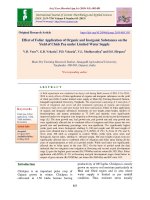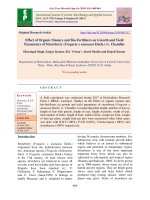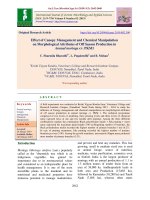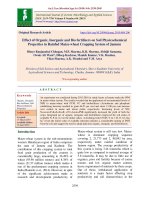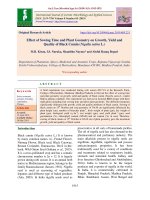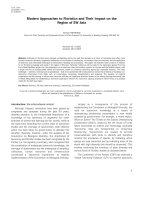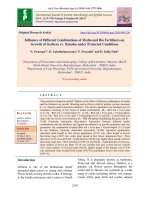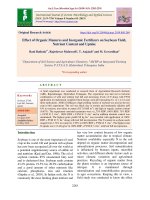Effect of organic manures and chemical fertilizers on the yield of rice seed “Lalat”
Bạn đang xem bản rút gọn của tài liệu. Xem và tải ngay bản đầy đủ của tài liệu tại đây (415.19 KB, 6 trang )
Int.J.Curr.Microbiol.App.Sci (2018) 7(10): 2161-2166
International Journal of Current Microbiology and Applied Sciences
ISSN: 2319-7706 Volume 7 Number 10 (2018)
Journal homepage:
Original Research Article
/>
Effect of Organic Manures and Chemical Fertilizers on the
Yield of Rice Seed “Lalat”
L.C. Naorem*
Central Research Station in Farming System Research, OUAT, Bhubaneswar, India
*Corresponding author
ABSTRACT
Keywords
Rice seed, Lalat, Organic
manures, Chemical
fertilizers
Article Info
Accepted:
15 September 2018
Available Online:
10 October 2018
The study was carried out to investigate the effect of organic manures and chemical
fertilizers on the yield of rice seed (Oryza sativa) during kharif 2015 at the Central
Research Station in Farming System Research, OUAT, Bhubaneswar in a Randomised
Block Design with 3 replications and 8 treatments having rice variety “Lalat ”. From the
experiment result, it was observed that the application of 100% NPK+25 Kg ZnSO 4 (T7)
produced the highest number of grain/panicle, 1000 grain wt., straw yield, grain yield with
chaff, grain yield without chaff and harvest index whereas highest panicle and sterile
grain/ panicle was recorded in T8 (T7 + residue recycling).
Introduction
Rice (Oryza sativa) is one of the most
important food crops of India in term of area,
production and consumer preference. It
provides over 21% of the calorific needs of the
world‟s population and upto 76% of the
calorific intake of the population of South East
Asia. It is one of the main sources of
carbohydrate and also contains considerable
amount of protein, minerals and vitamins.
India is the second largest producer and
consumer of rice in the world.
In Orissa rice is synonymous with food;
agriculture in Orissa to considerable extent
means growing rice. Rice covers about 69
percent of cultivated area and is the major
crop covering about 63 percent of total area
under food grains. It is the staple food of
almost entire population of Orissa and
therefore, the state economy is directly linked
with the improvement in production and
productivity of rice in the state.
Today, global agriculture is at crossroads as a
consequence of climatic change, increased
population
pressure
and
detrimental
environmental impacts. Increased population
needs more food to live on the Earth. India is
an agricultural country. Indian population has
already crossed 125 crores and it ranks second
position in the world. The food production
should be increased with the geometrically
growing population. In India, there is a
constant pressure on crop production from
2161
Int.J.Curr.Microbiol.App.Sci (2018) 7(10): 2161-2166
available cultivable land with limited water
resources in order to keep pace with the food
requirements
for
an
ever-increasing
population. Application of suitable fertilizers
is one of the ways to attain maximum crop
yield. Chemical fertilizer is the major supplier
of nutrients besides organic and green
manures. The use of chemical fertilizers has
been kingpin of modern agriculture. This
undoubtedly boosted the food production but
at the same time, it shows the negative effects
on physio-chemical properties of soil, nitrogen
transformation, macro and micronutrient
uptake and nutritional composition (Mahesh
and Hosmani, 2004). Application of suitable
fertilizers is one of the ways to attain
maximum crop yield. Chemical fertilizer is the
major supplier of nutrients besides organic and
green manures. The production of rice is
however, facing a sustainability problem due
to practices of modern production system with
indiscriminate use of chemical fertilizers and
pesticides (Duxbury et al., 2000; Ladha et al.,
2000). Hence, the present study was planned
with an objective to investigate the effect of
selected organic manures and chemical
fertilizer on the yield of Rice seed "Lalat”.
T3: 50% N as FYM+ 50% N as Azospirillum
+ RP + PSB
T4: T1 + Azospirillum + PSB
T5: 50% RDF + 50% N as FYM (8t/ha)
T6: 100% NPK
T7: 100% NPK + 25 Kg ZnSO₄
T8: T7 + residue recycling
Plot size
4.5m × 5m
Incorporation of green manure Dhainca
(Sesbania aculeta)
Dhaincha at the rate of 25 kg/ ha was sown 1
month before transplanting of rice crop in T1,
T2 and T3. Prior to transplanting the dhaincha
crop was incorporated into the soil.
Raising of seedlings
Seedlings were raised in wet nursery bed.
Prior to sowing in the nursery beds, the seeds
were soaked for 24 hours in water. After
draining out the water, seeds were incubated
for sprouting.
Materials and Methods
Experimental design
The experimental site was selected in Central
Research Station, OUAT, Bhubaneswar. The
experiment was designed with Randomised
Block Design having 8 treatments and 3
replication. The treatments were as follows
involving both chemical, biofertilizer, FYM,
non-edible oil.
T1: Different organic sources equivalent to 1/3
of recommended N (1/3N as FYM@ 5.5t/ha;
1/3N as Dhaincha, 1/3N as NEO).
T2: T1 + agronomic practice for weed and pest
control (without chemical pesticides)
The seed rate used was 30 kg/ha. After 4th day,
1-2 cm standing water was allowed in the
nursery bed.
Preparation of plot
The field was thoroughly ploughed to make
the soil well pulverized. Laddering was done
for proper leveling of the plot.
Two drainage- cum- irrigation channels were
prepared between the strips and bunds were
raised around the main plot and each sub-plot.
2162
Int.J.Curr.Microbiol.App.Sci (2018) 7(10): 2161-2166
Fertilizer application
Biometric observation
The major nutrients applied viz. nitrogen,
phosphorus and potassium were applied as per
recommendation (80 kg N + 40 kg P2O5 + 40
kg K2O/ha). FYM 20t/ha applied 15 days in
advance to avoid immobilization of nitrogen.
Panicle length
10 packets (2 kg/ha) each of Azospirillum and
Phosphobacteria were mixed with 25 kg FYM
and 25 kg of soil and mixture broadcasted
uniformly in the main field before
transplanting. Non edible neem seed cake @
250-400 Kg per hectare was applied as soil
application.
The length of the effective panicles in the
sample hills was measured from neck node to
tip and was expressed in centimeter and the
mean value was computed.
Number of grains per panicle
Total number of seeds formed in each panicle
in sample hills was counted and the mean was
computed.
Fertile grains per panicle
Transplanting
21 days old seedlings were transplanted in the
main field at a spacing of 20 cm × 10 cm with
2-3 seedlings per hill.
Number of filled seeds in each panicle in
sample hills was counted and the mean
computed.
Sterile grains per panicle
Irrigation
After transplanting of seeds, flood irrigation
was given to facilitate availability of enough
moisture to the seeds to initiate the process of
growth of the crop. Irrigation was given as and
when required.
Weeding and plant protection measures
In order to keep the crop weed free, hand
weeding was done. Prophylatic plant
protection measures were adopted to protect
the crop from diseases and pest attack.
Number of chaffy/ empty seed in each panicle
in sample hills was counted and the mean
value computed.
Seed yield per hectare
The total seed yield in each replication on
each treatment was determined. From the
observation data, the seed yield per hectare
was computed and expressed in kg/ha.
Straw yield per hectare
The total straw yield in each plot was recorded
and the straw yield per hectare was computed
and expressed in kg/ha.
Harvesting
When the crop approached harvestable
maturity stage, the plants belonging to each
treatment and replication were harvested
separately. The harvested plants are threshed;
seeds were cleaned, dried and graded. The
graded seeds were weighed to compare the
seed yield.
1000 seed weight
After harvest of the seed crops and completion
of post-harvest operation, 1000 seeds were
counted from each replication under each
treatment. The weight of 1000 seeds was taken
2163
Int.J.Curr.Microbiol.App.Sci (2018) 7(10): 2161-2166
by an electronic balance and expressed in
gram.
Harvest index (HI)
Harvest index is defined as the ratio of
economic yield to the biological yield and it
was calculated by using the formula given by
Donald (1962)
Harvest index (%) = Grain yield / Biological
yield × 100.
Results and Discussion
The data (Table 1 and 2) indicated that the
Maximum panicle length of 27.82 was
obtained in T8 Similar results have been
obtained by Muhammad et al., 2014 in rice.
Highest grain/panicle was observed in T7
(145.67).The findings were agreement with
Yadav et al., 2010 in hybrid rice. Maximum
number of fertile grain/panicle was obtained
from T7 (78.10). This confirms the study of
Tabar Y.S 2012 and Mahajan et al., 2012 in
rice whereas maximum sterile grain/panicle
was observed in T5 (26.33).
The highest test weight was 26.17 g per 1000
seeds in T7 and lowest was 22.63 g per 1000
seeds in T5. The present result is also in
conformity with Muhammad et al., (2014) but
contradicts the findings of Singh et al., (2000),
Singh et al., (2009), Yadav et al., (2009),
Kumari et al., (2010) in rice with organic
source of nutrient management.
Table.1 Effect of organic crop management practices on yield attributing characters
Treatments
T1(Different
organic
sources equivalent to 1/3 of
recommended N(1/3 as FYM
@ 5.5 t/ha,1/3 N as
Dhaincha,1/3 N as NEO)
T2
T1+
Agronomic
practices for weed and pest
control (Without chemical)
T3- 50% N as FYM + 50% N
as Azospirillum + RP + PSB
T4- T1+ Azospirillum + PSB
T5-50% RDF + 50% N as
FYM (8t/ha)
T6-100% NPK
T7-100% NPK + 25 Kg
ZnSO4
T8-T7+ residue recycling
S.Em±
CD(0.05)
CV
Panicle
length
(cm)
25.61
Grain
/panicle
Sterile
grain
/panicle
23.47
1000 grain
wt.(gm)
110.53
Fertile
grain
/panicle
74.83
26.02
125.93
77.20
22.57
24.67
23.43
110.53
73.93
25.62
22.86
25.64
24.41
110.87
107.87
75.63
73.67
22.83
26.33
23.98
22.63
26.15
26.56
126.20
145.67
77.23
78.10
22.40
20.15
24.98
26.17
27.82
138.27
78.03
20.60
25.94
0.672
2.039
4.529
6.303
19.120
8.948
1.520
NS
3.460
1.275
3.869
9.606
0.513
1.557
3.661
2164
23.00
Int.J.Curr.Microbiol.App.Sci (2018) 7(10): 2161-2166
Table.2 Contd….
Treatments
T1(Different organic sources equivalent
to 1/3 of recommended N(1/3 as FYM@
5.5 t/ha,1/3 N as Dhaincha, 1/3 N as NEO
T2-T1+Agronomicpractices for weed and
pest control (without chemical)
T3- 50% N as FYM +50% N as
Azospirillum + RP + PSB
T4-T1+ Azospirillum + PSB
T5-50% RDF +50% N as FYM (8t/ha)
T6-100% NPK
T7-100% NPK+25Kg ZnSO4
T8-T7+Residue recycling
S.Em±
CD(0.05)
CV
Straw
Yield
(t/ha)
Grain
Yield
without
chaff (t/ha)
5.1
Harvest
Index
Lodging
(%)
5.61
Grain
Yield with
chaff
(t/ha)
6.5
0.476
13.33
5.67
6.5
5.4
0.487
16.67
4.95
5.8
4.4
0.470
15.00
5.23
5.5
5.01
5.78
5.72
0.004
0.012
0.131
5.9
5.9
5.8
7.5
6.7
0.120
0.363
3.273
4.9
5.0
4.9
6.1
5.9
0.048
0.146
1.599
0.483
0.476
0.494
0.513
0.507
0.001
0.004
0.438
10.00
43.33
68.33
86.67
78.33
6.474
19.637
27.048
The highest straw yield of 5.78 t/ha was
obtained from T7 this is in agreement with Feng
2010 and Yagoub S.O. et al., 2012 in soybean.
Highest grain yield with chaff was recorded in
T7 (7.5 t/ha) followed by T8 (6.7 t/ha). Similarly,
Grain yield without chaff was highest in T 7 (6.1
t/ha) followed by T8 (5.9 t/ha). Judicious and
proper use of fertilizers can markedly increase
the yield and improve the quality of rice.
Results of the present investigation are in
agreement with Gupta et al., (2006) and
Rehman et al., (2010) in rice.
The highest harvest index was observed in T7
(0.513) followed by T8 (1.77). This confirmed
the report of several earlier workers in seeds of
different crop (Muhammad et al., 2014 in rice
and Yagoub et al., (2012) in soybean. The
highest lodging % occur in T7 (86.67%)
followed by T8 (78.33) and least in T4 (10 %).
This may be higher translocation of nutrients
from the source to sink. Since rice is widely
used as a staple food in most of the Indian states
and majority of the studies on rice is mainly
based on the use of inorganic chemical
fertilizers to increase its productivity. However
the use of such chemical fertilizers hampers the
eco-system in general and soil quality in
particular. As such there is an urgent need to
focus more on the cultivation of rice organically
and judicious use of recommended chemical
fertilizers to increase its yield and to keep the
eco-system intact. The present study focuses on
the effect of organic manures and chemical
fertilizers on the yield of rice seed (Oryza
sativa). For the present study the rice variety
„lalat‟ has been chosen because of its widely
used rice variety in Orissa as well its nutritional
values.
From the study it has been found that seed yield
of rice c.v. Lalat were enhanced due to various
nutrient management practices. Between the
organic sources of nutrients and inorganic
fertilizers, the highest yield as well as other
parameter were obtained from T7 (100% NPK
along with 25 kg ZnSO4).
2165
Int.J.Curr.Microbiol.App.Sci (2018) 7(10): 2161-2166
In the present contest organic management
practices of nutrient is considered to be suitable
for maintaining a healthy ecosystem with a
sustainable productivity. For quality seed
production in rice due emphasis should be given
on application of N in form of FYM and
Dhaincha.
References
Arif, Muhammad, Muhammad Tasneem, Fiaz
Bashir, Ghulam Yaseen, and Rana
Muhammad Iqbal. "Effect of integrated
use of organic manures and inorganic
fertilizers on yield and yield components
of rice." J. Agric. Res 52, no. 2 (2014):
197-206.
Feng, Y., L. Y. Cao, W. M. Wu, X. H. Shen, X.
D. Zhan, R. R. Zhai, R. C. Wang, D. B.
Chen, and S. H. Cheng. "Mapping QTLs
for nitrogen‐ deficiency tolerance at
seedling stage in rice (Oryza sativa
L.)." Plant Breeding 129, no. 6 (2010):
652-656.
Gupta, Vikas, R. S. Sharma, and S. K.
Vishwakarma. "Long-term effect of
integrated nutrient management on yield
sustainability and soil fertility of rice
(Oryza sativa)–wheat (Triticum aestivum)
cropping system." Indian Journal of
Agronomy 51, no. 3 (2006): 160-164.
Ladha,
Jagdish
Kumar. Improving
the
productivity and sustainability of ricewheat systems of the Indo-Gangetic
Plains: a synthesis of NARS-IRRI
partnership research. No. 40. Int. Rice
Res. Inst., 2000.
Mahesh, M. K., and S. P. Hosmani.
"Morphological changes and nutrient
uptake in some cultivars of rice treated
with Bavistin." Journal of Ecotoxicology
and Environmental Monitoring 14, no. 3
(2004): 195-198.
Niru, Kumari, Ashok Kumar Singh, S. K. Pal,
and R. Thakur. "Effect of organic nutrient
management on yield, nutrient uptake and
nutrient balance sheet in scented rice
(Oryza sativa)." Indian Journal of
Agronomy 55, no. 3 (2010): 220-223.
Singh, G. R., K. S. Pandya, N. K. Chaure, S. S.
Parihar, and K. K. Choudhary. "Soil
fertility, productivity and profitability of
rice under different organic manures."
Oryza 37, no. 3 (2000): 208-212.
Singh, R. P., P. K. Singh, and A. K. Singh.
"Effect of green manuring on physicochemical properties of soil and
productivity
of
rice." ORYZA-An
International Journal on Rice46, no. 2
(2009): 120-123.
Yadav, A. S., Ram Hardev, and M. K.
Upadhyay. "Effect of nitrogen levels and
plant geometry on growth, yield and root
characteristics of hybrid rice (Oryza
sativa)." Crop Research (Hisar) 40, no.
1/3 (2010): 16-19.
Yadav, D. S., Kumar Vineet, and Yadav Vivek.
"Effect
of
organic
farming
on
productivity, soil health and economics of
rice (Oryza sativa)-wheat (Triticum
aestivum) system." Indian Journal of
Agronomy 54, no. 3 (2009): 267-271.
Yagoub, Samia Osman, Wigdan Mohamed Ali
Ahmed, and A. A. Mariod. "Effect of
urea, NPK and compost on growth and
yield of soybean (Glycine max L.), in
semi-arid region of Sudan." ISRN
Agronomy 2012 (2012).
Yosef Tabar, S. "Effect of nitrogen and
phosphorus fertilizer on growth and yield
rice (Oryza sativa L.)." International
journal of agronomy and Plant
Production 3, no. 12 (2012): 579-584.
How to cite this article:
Naorem, L.C. 2018. Effect of Organic Manures and Chemical Fertilizers on the Yield of Rice Seed
“Lalat”. Int.J.Curr.Microbiol.App.Sci. 7(10): 2161-2166.
doi: />
2166

